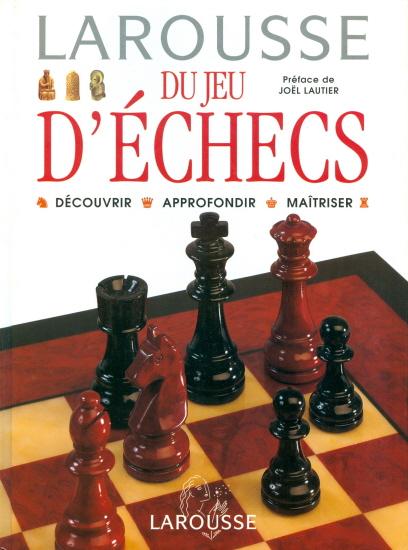
Edward Winter
(1997)

No author is cited on the cover or title page of the Larousse du jeu d’échecs, a 477-page hardback, produced with the cooperation of the French Chess Federation, but elsewhere there is a list of 20 contributors, headed by Marc Gatine. The unfamiliarity of almost all the names is easy to decry, but many poor books are inflicted on the chess world by familiar names. In a catchpenny move, the front cover mentions Joël Lautier, on the strength of a one-page preface which promises a work that is ‘the most complete and most erudite published to date’. If only. Left open or shut on a coffee table, the Larousse du jeu d’échecs is elegantly fetching, but the text is a cascade of factual blunders, misprints and general misconceptions.
All aspects of the game receive treatment of sorts, though barely venturing outside the groove of stereotyped facts and non-facts to be found in hundreds of earlier books. Even basic matters are maltreated. For example, ‘combination’ is defined on page 463 as ‘a sequence of moves made by a player which, if it is correct, compels the other player to make forced replies’. The section on endgame studies attributes to ‘Grigoriev, 1928’ the famous ‘fast king at h8’ position which Réti conceived in 1921. The following page (page 295) has ‘Treed’ instead of Teed and ‘Reichelm’ instead of Reichhelm. No chess authority nowadays would seem to write Alexander ‘MacDonnell’ rather than McDonnell, or Lionel ‘Kieseritsky’ rather than Kieseritzky, but the Larousse book does that and more. On page 233 (as well as in the lamentable index – why are French books never properly indexed?) we have ‘Milner-Berry’ instead of Milner-Barry. Page 301 refers to a publication called Workly Citizen, which should read [Glasgow] Weekly Citizen. On page 304 the co-author of L’Art de faire mat, called a bestseller, should read Victor Kahn, not Kann. When a surname is rendered correctly, the success may be spoilt by a bizarre forename. Page 342 has ‘James Marshall’, instead of Frank.
Marshall’s famous 12... Qxf3 sacrifice against Janowsky was played in Biarritz in 1912 and not, as claimed on page 45, in Paris in 1905. On page 208 the errors pile up when a position is marked ‘Potter v Mathews, London, 1951, Legal’s mate’. For Mathews read Matthews, for 1951 read 1868, and for Legal read Legall. (The game in question was given on page 178 of the Chess Players’ Quarterly Chronicle, 1868.) A couple of pages later comes the following diagram heading: ‘Tylar v Winter, Hastings, 1963’. Tylor and 1933 would be correct.
Erratic dates are a feature. Stating that the Kasparov v Short match was played in 1992, rather than 1993, may be easily done (page 121), but there is no excuse for repeating (on page 292) the old inaccuracy about Najdorf’s ‘Immortal Polish Game’ being played in 1935. And it takes special historical gifts to present a ‘study by Lucena, 1792’ (page 298), given that Lucena died around 1530. Page 228 calls Ragozin ‘a contemporary Russian player’. He died in 1962.
Morphy won the New York tournament in 1857 and played his match against Anderssen in December 1858, yet page 34 declares that ‘Morphy’s sparkling career lasted just over six months’. Capablanca did not challenge Lasker before his victory at San Sebastián, 1911 or lose to Lasker in the final round of St Petersburg, 1914. Both those mistakes are on page 47. On page 50 it is incorrectly stated that the 1927 Capablanca-Alekhine match lasted three months, and page 371 says that Alekhine was proclaimed world champion after the 27th (as opposed to the 34th) match game. Page 48 would have us believe that in 1921 Alekhine won a tournament in Havana. The Hague is naturally meant, i.e. La Haye and not La Havane. The Blumenfeld Gambit, so page 255 assures us, was ‘played for the first time in the 1922 Pistyan tournament by Blumenfeld’. He wasn’t even a participant.
The summaries of selected players’ careers (a chapter dubiously entitled ‘Dictionnaire des champions’) are grotesquely unbalanced. Let us not begrudge Julio Granda Zúñiga (born 1967) his 22-line biography, but, just below, Ernst Grünfeld is despatched with a mere ten. Beliavsky is granted 79 lines, as opposed to 33 for Pillsbury and 14 for Janowsky, a world championship challenger. Saint-Amant is described as ‘one of the best players of the 19th century’, but for his pains he is given only nine lines; in contrast, Lautier is allowed to bask in 169, plus a photograph. Kasparov is awarded roughly double that, but, in the meantime, the likes of Alapin, Bird, Burn, Colle, Harrwitz, Junge, Leonhardt, Mason, Showalter and Znosko-Borovsky get nothing.
The above strictures are, of course, merely a small cross-section, and they leave out of account the panoply of dogmatic and groundless opinions also pervading the book. It is France’s second such failure in recent years. (The first was Le guide des échecs by Nicolas Giffard and Alain Biénabe, published in 1993. Unsurprisingly, Mr Giffard was also on the Larousse team.) The most charitable view of the Larousse du jeu d’échecs – and this is faint praise indeed – is that it is better than Nathan Divinsky’s The Batsford Chess Encyclopedia (1990), which was lambasted by various critics, including (on pages 26-27 of ChessBase Magazin, July-August 1991) John Nunn. But Larousse is one of the world’s most prestigious names in publishing, and it is genuinely sad to see chess writers letting the company down so badly.
This article was originally published on pages 80-81 of the 8/1997 New in Chess.
To the Chess Notes main page.
To the Archives for other feature articles.
Copyright: Edward Winter. All rights reserved.